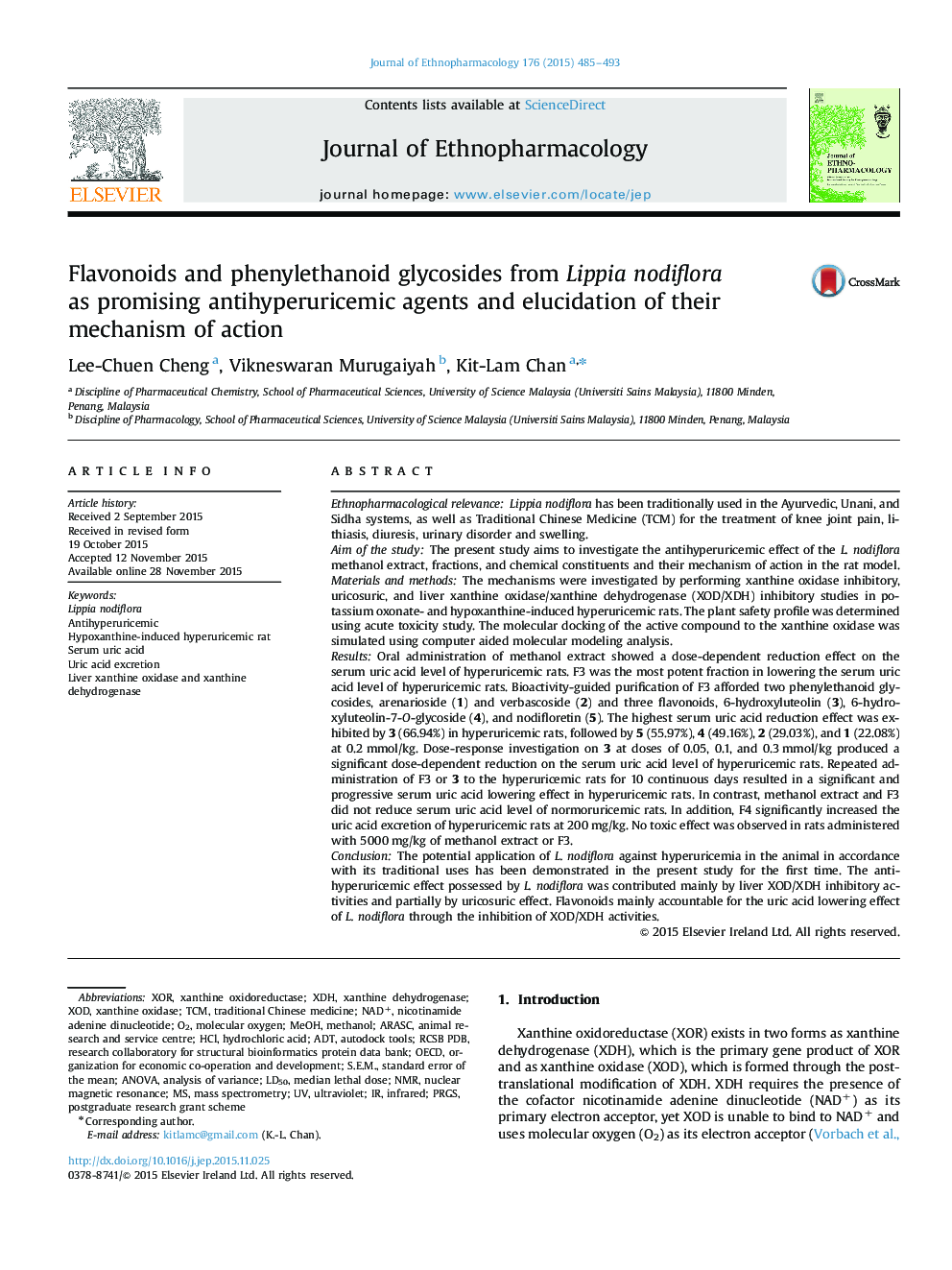| کد مقاله | کد نشریه | سال انتشار | مقاله انگلیسی | نسخه تمام متن |
|---|---|---|---|---|
| 5834994 | 1560386 | 2015 | 9 صفحه PDF | دانلود رایگان |

Ethnopharmacological relevanceLippia nodiflora has been traditionally used in the Ayurvedic, Unani, and Sidha systems, as well as Traditional Chinese Medicine (TCM) for the treatment of knee joint pain, lithiasis, diuresis, urinary disorder and swelling.Aim of the studyThe present study aims to investigate the antihyperuricemic effect of the L. nodiflora methanol extract, fractions, and chemical constituents and their mechanism of action in the rat model.Materials and methodsThe mechanisms were investigated by performing xanthine oxidase inhibitory, uricosuric, and liver xanthine oxidase/xanthine dehydrogenase (XOD/XDH) inhibitory studies in potassium oxonate- and hypoxanthine-induced hyperuricemic rats. The plant safety profile was determined using acute toxicity study. The molecular docking of the active compound to the xanthine oxidase was simulated using computer aided molecular modeling analysis.ResultsOral administration of methanol extract showed a dose-dependent reduction effect on the serum uric acid level of hyperuricemic rats. F3 was the most potent fraction in lowering the serum uric acid level of hyperuricemic rats. Bioactivity-guided purification of F3 afforded two phenylethanoid glycosides, arenarioside (1) and verbascoside (2) and three flavonoids, 6-hydroxyluteolin (3), 6-hydroxyluteolin-7-O-glycoside (4), and nodifloretin (5). The highest serum uric acid reduction effect was exhibited by 3 (66.94%) in hyperuricemic rats, followed by 5 (55.97%), 4 (49.16%), 2 (29.03%), and 1 (22.08%) at 0.2Â mmol/kg. Dose-response investigation on 3 at doses of 0.05, 0.1, and 0.3Â mmol/kg produced a significant dose-dependent reduction on the serum uric acid level of hyperuricemic rats. Repeated administration of F3 or 3 to the hyperuricemic rats for 10 continuous days resulted in a significant and progressive serum uric acid lowering effect in hyperuricemic rats. In contrast, methanol extract and F3 did not reduce serum uric acid level of normoruricemic rats. In addition, F4 significantly increased the uric acid excretion of hyperuricemic rats at 200Â mg/kg. No toxic effect was observed in rats administered with 5000Â mg/kg of methanol extract or F3.ConclusionThe potential application of L. nodiflora against hyperuricemia in the animal in accordance with its traditional uses has been demonstrated in the present study for the first time. The antihyperuricemic effect possessed by L. nodiflora was contributed mainly by liver XOD/XDH inhibitory activities and partially by uricosuric effect. Flavonoids mainly accountable for the uric acid lowering effect of L. nodiflora through the inhibition of XOD/XDH activities.
337
Journal: Journal of Ethnopharmacology - Volume 176, 24 December 2015, Pages 485-493